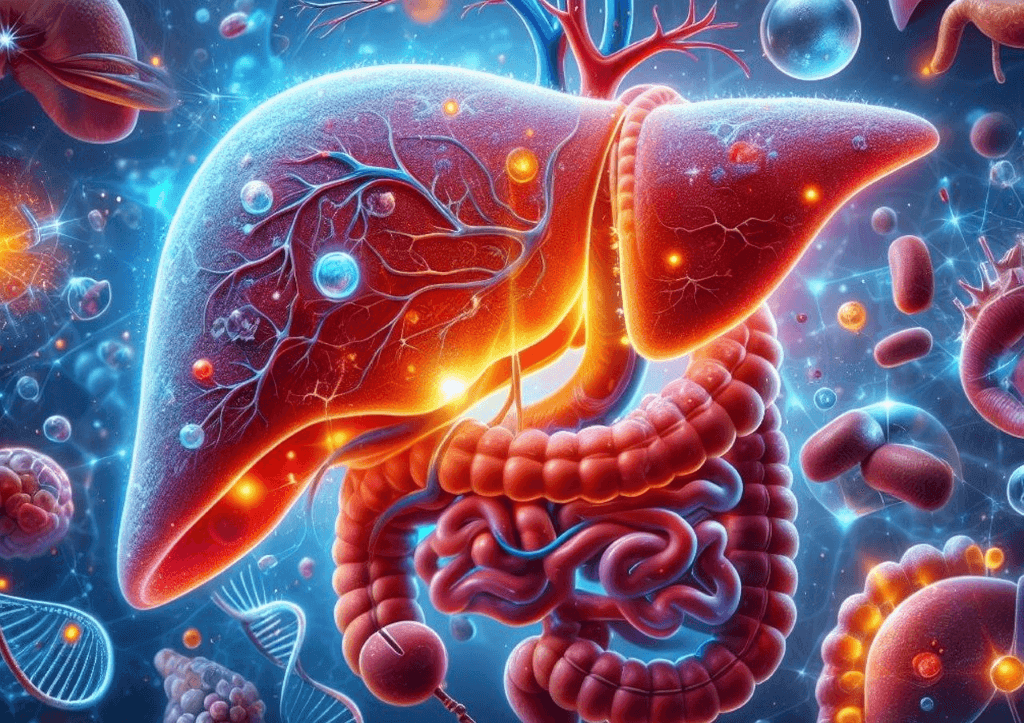Fatty liver disease (FLD) occurs when there is an excessive accumulation of fat in the liver cells. The condition has varying degrees of severity. Initially, there are usually no discernible symptoms, but as the condition progresses, it can bring about severe health challenges, including cirrhosis and liver cancer, if left unmanaged.
Fatty liver manifests in two ways. It can be caused by excessive alcohol consumption, known as Alcoholic Fatty Liver Disease (AFLD) or various other factors, known collectively as Non-Alcoholic Fatty Liver Disease (NAFLD). According to an American Liver Foundation report, an estimated 25% of US adults have non-alcoholic fatty liver disease (NAFLD), making it the most common liver disorder in the country. In addition, just under 5% have ALFD, as set out in this study published in the National Library of Medicine.
Understanding Fatty Liver Disease
Fatty liver disease is a spectrum of liver conditions resulting from fat buildup in liver cells. The primary types of FLD are:
- Non-alcoholic Fatty Liver Disease (NAFLD): In this form, fat buildup is closely linked to metabolic conditions such as obesity, insulin resistance, and type 2 diabetes. NAFLD can range from simple steatosis (fat accumulation without inflammation) to non-alcoholic steatohepatitis (NASH), a severe form of FLD that can lead to fibrosis and cirrhosis, significantly increasing the risk of liver failure and liver cancer.
- Alcoholic Fatty Liver Disease (AFLD): AFLD results from long-term excessive alcohol consumption, which can lead to fat accumulation in the liver. The liver is responsible for metabolizing alcohol, and excessive intake can overwhelm this process, leading to fat buildup. Continued alcohol consumption can result in more severe liver conditions, including alcoholic hepatitis and cirrhosis.
Age plays a significant role in the development of FLD, particularly in individuals over the age of 50. This increased risk results from changes in metabolism, hormonal shifts, and the development of other health conditions, such as type 2 diabetes and cardiovascular diseases.
Causes of Fatty Liver Disease
Fatty Liver Disease can be caused by a combination of lifestyle choices, genetic predispositions and underlying health conditions. Key contributing factors include:
- Lifestyle Factors:
- Diet: Diets high in refined sugars, saturated fats, and processed foods contribute to liver fat accumulation, which can lead to insulin resistance, a critical factor in the development of NAFLD.
- Alcohol Consumption: Sustained excessive alcohol intake is the primary cause of AFLD.
- Physical Inactivity: A sedentary lifestyle contributes to obesity and insulin resistance, both of which are significant risk factors for FLD.
- Metabolic Disorders:
- Obesity: Excess adipose tissue, particularly visceral fat, contributes to insulin resistance and inflammation.
- Type 2 Diabetes: Insulin resistance, a hallmark of type 2 diabetes, leads to increased fatty acid synthesis in the liver.
- Metabolic Syndrome: This manifests through the simultaneous presence of a combination of conditions such as abdominal obesity, high blood pressure, high triglycerides, low HDL cholesterol, and high fasting glucose levels and is a significant risk factor for NAFLD.
- Other Potential Causes:
- Certain Medications: Some medications, including corticosteroids, tamoxifen, and certain antiviral drugs, can lead to liver fat accumulation as a side effect.
- Viral Hepatitis: Hepatitis C, particularly genotype 3, is associated with an increased risk of fatty liver. Chronic hepatitis C infection can exacerbate the progression of NAFLD.
Health Risks Associated with Fatty Liver Disease
The health risks associated with FLD vary depending on the severity of the condition and the presence of inflammation or liver damage. The most significant long-term risks are:
- Liver Inflammation and NASH: NASH is a severe form of advanced FLD involving inflammation and liver cell damage. NASH can lead to fibrosis, where the liver tissue becomes scarred.
- Cirrhosis: As NASH progresses, fibrosis can lead to cirrhosis, an irreversible condition that impairs liver function and can cause complications like portal hypertension, liver failure, and the need for a liver transplant.
- Liver Cancer: NAFLD and NASH increase the risk of hepatocellular carcinoma, a type of liver cancer. This risk is especially high in those with cirrhosis.
Diagnosing Fatty Liver Disease
Diagnosing FLD involves a combination of clinical evaluation, laboratory tests, and imaging studies. The diagnostic process typically includes:
- Blood Tests: Liver function tests (LFTs) are usually the first step in diagnosing FLD. Elevated levels of liver enzymes may indicate liver damage.
- Ultrasound: This non-invasive imaging test can detect fat accumulation in the liver.
- MRI and CT Scans: These imaging modalities provide more detailed images of the liver, helping to assess the extent of fat accumulation and fibrosis.
- Liver Biopsy: In cases where the diagnosis is uncertain or to assess the severity of liver damage, a liver biopsy may be performed.
Preventing and Treating Fatty Liver Disease
Preventing FLD or reversing its progression focuses on making lifestyle changes and managing any underlying comorbidities. There are no approved medications for the treatment of FLD. In managing associated conditions such as diabetes and hyperlipidemia, however, medications may be prescribed to control blood sugar levels and cholesterol. Typical treatment strategies include:
- Dietary Changes:
- Whole Foods: Emphasize the consumption of nutrient-dense foods such as vegetables, fruits, whole grains, and lean proteins. These foods provide essential vitamins, minerals, and antioxidants that support liver health.
- Healthy Fats: Incorporate sources of healthy fats, such as avocados, nuts, seeds, and olive oil. These fats can help reduce inflammation and improve lipid profiles.
- Fiber Intake: A diet high in fiber can help regulate blood sugar levels and reduce the risk of insulin resistance. Fiber-rich foods include vegetables, fruits, legumes, and whole grains.
- Regular Exercise:
- Aerobic Exercise: Activities like brisk walking, jogging, cycling, and swimming can help burn calories and reduce liver fat.
- Strength Training: Resistance exercises, such as weight lifting or bodyweight exercises, help build muscle mass, which can improve metabolism and insulin sensitivity.
- Weight Management Strategies:
- Setting Realistic Goals: Aim for a gradual and sustainable weight loss, which is more likely to be maintained long-term. Rapid weight loss can sometimes worsen liver inflammation.
- Behavioral Changes: Incorporate healthy eating habits, such as mindful eating, portion control, and reducing the intake of processed foods and sugary beverages.
- Alcohol Consumption:
- For individuals with AFLD or at risk of liver disease, limiting or completely avoiding alcohol is crucial. Even small amounts of alcohol can exacerbate liver damage in those with existing FLD.
- Importance of Regular Check-ups and Monitoring:
- Regular medical check-ups allow for early detection and more accurate management of liver-related issues. Healthcare providers can monitor liver function tests, assess the effectiveness of treatment, and adjust management plans as needed.
Conclusion
Fatty liver disease is far more common than most people realize, and it is perilously underestimated. More alarming, though, is that the prevalence continues to increase due largely to modern lifestyle factors. The good news is that you do not need to be a statistic. FLD, in most cases, is very preventable and treatable. All it takes is the determination to stand up to it.
At LL Medico, we believe in growing old in good health and with dignity. With around 30 years of experience in the field of senior care products, we have the knowledge and the products to support you on your journey. Whether you need nutritional supplements to ensure a healthy, balanced diet, mobility aids to support aging joints while you exercise, or diabetic supplies to help you keep your glucose in check, LL Medico has your back. Give us a call today at (855) 422-4556 or email support@llmedico.com. From Monday to Friday, 9 am to 5 pm EST, you can also chat with us online.






 855-422-4556
855-422-4556 Chat
Chat E-Mail
E-Mail Monday - Friday 9:00AM to 5:00PM EST
Monday - Friday 9:00AM to 5:00PM EST






 Shopping With LL Medico
Shopping With LL Medico



 855-422-4556
855-422-4556